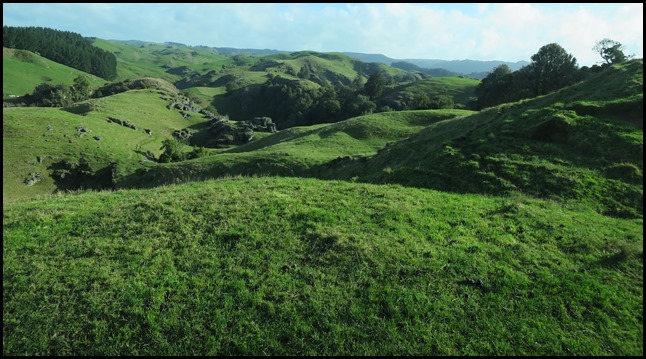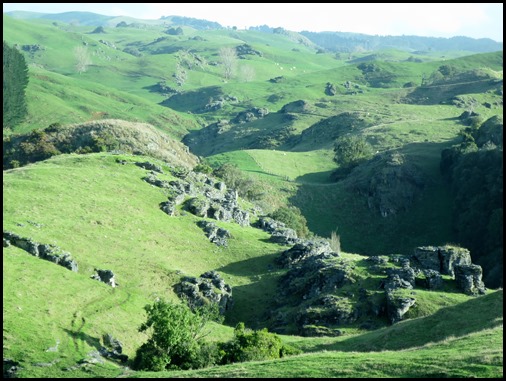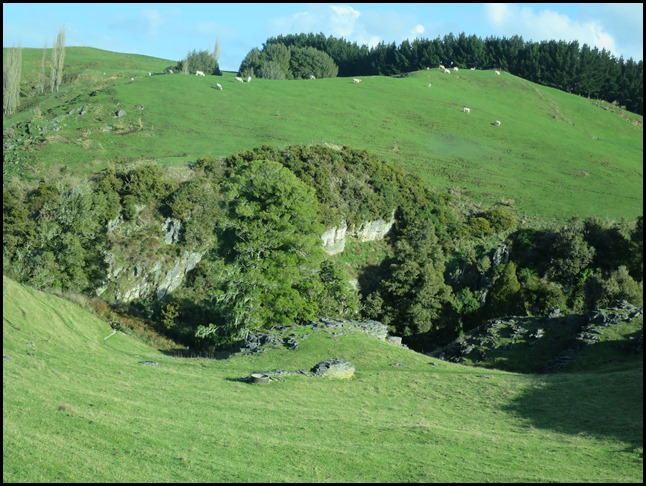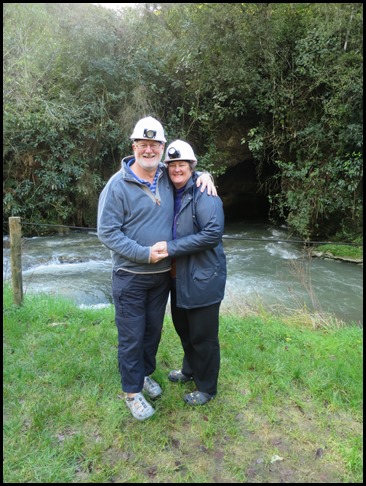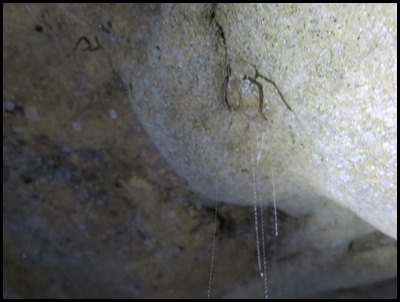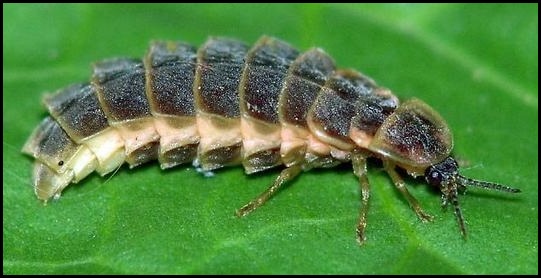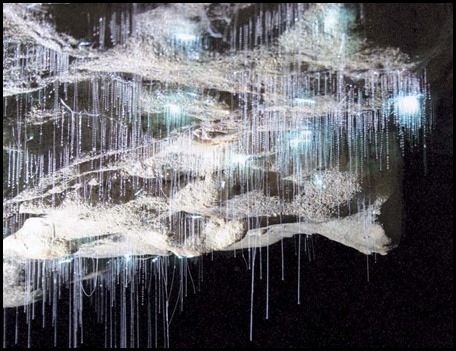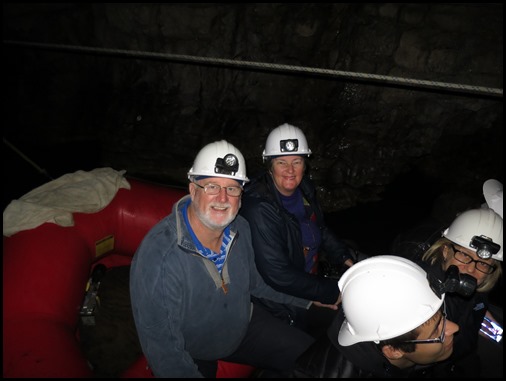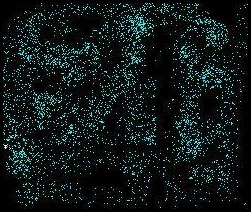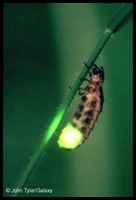Waitomo Caves

|
Waitomo Cave and a Milky Way of Glow-worms
We drove the short distance from Kiwi House to the Visitor Centre of the Waitomo Caves. As soon as we left the main road the landscape changed from rolling to lumpy, very technical dear. Watch it. This tiny area is home to forty one people, a campsite, a museum, a tiny general store, one hotel, a cafe and a restaurant. The famous caves are the place to see glow-worms in New Zealand, some say anywhere. We were just in time for the two o’clock tour with Norm. He packed ten of us in his transit van and off we went.
The bumpy, unmade road wiggled along for half an hour, en route Norm stopped and pointed out various cracks, faults and fissures. During the history of the area one eruption caused dust to travel as far as China and Italy – as tested by ‘them in the know’.
There are a great many sheep farms in the area, some for meat, some for wool which ranges from carpet quality to fine gloves and every colour from pure white to almost jet black. There was one farm, owned by a lady who takes in dairy cows, charged on a daily basis, who come here on holiday............... Norm stopped and pointed to a sink hole, a cavers target, of which there are many. Some go nowhere, some can be used for abseil training and others link to the main caves that stretch over a great distance.
Out of the van, we crossed a field full of sheep droppings and stood beside a stream to befitted out with hard hats.
A few yards into Waitomo Cave we stopped and saw our first dangling traps and our first glow-worm, which looked like a tiny brown caterpillar. None of the world’s glow-worms are true worms. In the northern hemisphere the name is used for beetles that fly around at night with their tail-lights flashing. In New Zealand and Australia, glow-worms are the larvae (maggots) of a special kind of fly known as a fungus gnat. Fungus gnats look rather like mosquitoes, and most feed on mushrooms and other fungi. However, a small group of fungus gnats are carnivores, and the worm-like larvae of these species use their glowing lights to attract small flying insects into a snare of sticky threads. One species, Arachnocampa luminosa, is found throughout New Zealand, and others occur in Australia. Hundreds of Arachnocampa larvae may live side by side on a damp sheltered surface, such as the roof of a cave or an overhanging bank in the forest. Their lights resemble a star-filled night sky. Māori call them titiwai, which refers to lights reflected in water. Norm said that glow-worm sounded so much better than glow-maggot, not sure because whatever they are called they do impress.
Beetle or Fly: It was first thought that the only insects that glowed were beetles, such as the northern hemisphere fireflies. So people believed that New Zealand’s glow-worms must be beetles too. But in the 1880’s, George Vernon Hudson took glow-worm larvae from the Wellington Botanic Garden and raised them in a tank. He showed that they had a pupa stage and then emerged as a special type of adult fly – known as a fungus gnat.
Habitat: Glow-worms need damp places, where the air is humid and still, to construct their snares. Caves and old mining tunnels are ideal. In the forest glow-worm snares are commonest on moist banks beside a stream or in a ravine.
Prey: Small midges are the usual prey of glow-worms, but all sorts of flying insects get trapped in the sticky snares, including mayflies, caddisflies and moths. Forest glow-worms may also trap spiders, plant hoppers and even millipedes. The glow-worm simply cuts free any prey that is too large, or unwanted. Adult glow-worm flies are never caught in the snares – they are not attracted to the light, and even if they brush against the sticky threads they are strong enough to pull free.
We were asked to switch our lamps off, we could see just a few ‘glows’, as our eyes got used to the darkness we saw a few more.
Lights back on, we made our way along the path to a waiting dinghy. Norm settled us row by row.
Once again we switched off our lamps and Norm requested silence. He pulled the dinghy along a series of overhead lines and we listened to a waterfall some way off, other than that quiet. The picture above was emailed to us as a keepsake, it is just as we saw. When we were deep into the cave the sight was like looking up at the Milky Way, thousands of twinkling lights, dark areas in the ridges of the ceiling, great swathes on the flatter parts.
Light display: The glow-worm’s tail-light shines from an organ which is the equivalent of a human kidney. All insects have this organ but the glow-worm has a unique ability to produce a blue-green light from it. The chemical reaction that produces the light consumes a lot of oxygen. An airbag surrounds the light organ, providing it with oxygen and acting as a silvery reflector to concentrate the light. A fungus gnat can glow at all stages of its life cycle (except as an egg), but the larva has the brightest light. In caves the insects light up at any time of the day or night. Outdoor glow-worms start glowing shortly after dark and usually shine all night. Sometimes when a glow-worm is disturbed its light seems to go off suddenly. This is the larva slithering into a crevice, hiding its light. It actually takes several minutes for the larva to shut off the light.
Life cycle: Glow-worms are the larvae of the fungus gnat, whose life cycle has four stages: · Eggs are laid by the adult fly. Larvae (maggots) hatch three weeks later. · A young larva is only a few millimetres long. Over six to nine months the larva grows steadily until it is about 3–4 centimetres long. It hangs loosely from a damp, sheltered surface, inside a horizontal tube made of very flexible silk and mucus. When mature the larva becomes a pupa. · In the pupal or cocoon stage the pupa hangs vertically from a thread for about two weeks until emerging as an adult fly. · The adult fly cannot feed and lives only a few days – enough time to mate, and for the female to lay about 100 eggs.
Snares: To catch small flying insects, the glow-worm sets up a snare of sticky silk threads. Flying insects see the glow-worm’s light in the dark and fly towards it, because it resembles moonlight shining through the trees. Instead of finding freedom, they become trapped on the sticky threads. Their struggles alert the glow-worm, which pulls in the thread with its mouth. The prey is then killed and eaten. Glow-worm lines vary greatly in number and length, depending on the size of the larva and where it is living. Forest-dwelling glow-worms hang lines that are only 1–2 centimetres long, because they could get tangled in a breeze. In the still air of caves, lines can reach up to half a metre. Each line is made of silk with droplets of sticky mucus – like beads on a string. The larva spends much of its time making and repairing the lines. Because of the flexible nature of its tube, the larva can push its head out to grab a line, ingesting it for re-use later.
ALL IN ALL ONE OF NATURES LITTLE WONDERS A BRIGHT BLUE MILKY WAY |
